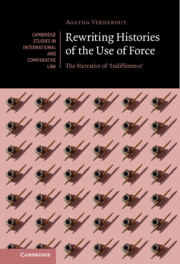Book contents
- Rewriting Histories of the Use of Force
- Cambridge Studies in International and Comparative Law: 160
- Rewriting Histories of the Use of Force
- Copyright page
- Contents
- Foreword
- Acknowledgements
- Abbreviations
- Introduction
- Part I The Use of Force in Nineteenth-Century Doctrine
- 1 The ‘Use of Force’ in the Nineteenth Century
- 2 The Use of Force in Writings of ‘Naturalist’ Inclination
- 3 The Use of Force in Writings of ‘Eclectic’ Inclination
- 4 The Use of Force in Writings of ‘Positivistic’ Inclination
- Conclusion of Part I
- Part II The Use of Force in Nineteenth-Century Practice
- Part III The Narrative of Indifference in the Twentieth Century
- Conclusion
- Bibliography
- Index
- Cambridge Studies in International and Comparative Law
1 - The ‘Use of Force’ in the Nineteenth Century
Some Conceptual Clarifications
from Part I - The Use of Force in Nineteenth-Century Doctrine
Published online by Cambridge University Press: 10 September 2021
- Rewriting Histories of the Use of Force
- Cambridge Studies in International and Comparative Law: 160
- Rewriting Histories of the Use of Force
- Copyright page
- Contents
- Foreword
- Acknowledgements
- Abbreviations
- Introduction
- Part I The Use of Force in Nineteenth-Century Doctrine
- 1 The ‘Use of Force’ in the Nineteenth Century
- 2 The Use of Force in Writings of ‘Naturalist’ Inclination
- 3 The Use of Force in Writings of ‘Eclectic’ Inclination
- 4 The Use of Force in Writings of ‘Positivistic’ Inclination
- Conclusion of Part I
- Part II The Use of Force in Nineteenth-Century Practice
- Part III The Narrative of Indifference in the Twentieth Century
- Conclusion
- Bibliography
- Index
- Cambridge Studies in International and Comparative Law
Summary
This chapteraims to bringsome conceptual clarifications around the use of the term ‘use of force’ in nineteenth-century international law. This expression was only consecrated as a legal concept with the adoption of the UN Charter. Beforehand, States and doctrine rather spoke of ‘intervention’, of ‘armed reprisals’ (or ‘measures short of war’), and ‘war’ to designate the different forms the use of armed force could take. It is hence important to clarify these different notions in order to understand what they encompassed, how they differed, but also sometimes overlapped. It shows that the notion of intervention was understood very broadly and, to a large extent, included the two others. It also highlights the conceptual and practical difficulties involved with distinguishing armed reprisals (supposedly regulated by the laws of peace) and resort to war (supposedly regulated by the laws of war). Not only did they involve the same type of actions but they were also justified in the same circumstances – i.e. to redress an offense. It concludes that, contrarily to what is generally assumed, the different types of use of force depended on a single legal regime: that of intervention.
Keywords
- Type
- Chapter
- Information
- Rewriting Histories of the Use of ForceThe Narrative of ‘Indifference', pp. 19 - 35Publisher: Cambridge University PressPrint publication year: 2021

